


No matter what your injury, the vast majority of your recovery is dependent on your body healing itself. No matter how you describe your injury, whether it's a tear or strain or sprain or inflammation, your soft tissue is repaired by your own body. There's no exception. The healing process is incredibly complex. And, it goes on for a lot longer than you think. The pain may be gone in a few weeks, but your body continues to heal itself long after the pain has disappeared. It is very common for the full healing process to continue for 2 years or longer, even for rather minor injuries.
If you have a soft tissue injury, your body has to heal itself.
Our body's ability to heal is truly remarkable. Below we attempt to explain this very magical process in simple terms. Understanding what is going on in your body is an important part of taking care of your injury. We hope this explanation will help you to better understand the healing process so you can heal more quickly and completely.
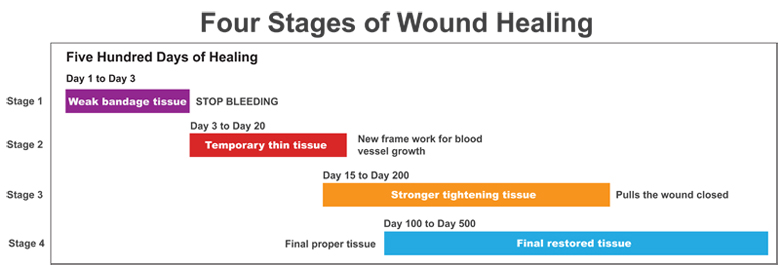
Whether it's skin, cartilage, a tendon, a ligament, or a muscle, when we injure ourselves we have typically caused our tissue to tear. Perhaps a little bit, perhaps a lot. The injury or wound can affect a small or large area. Immediately upon wounding soft tissue, the fluids (blood, lymph and other fluids) in our body leak from the broken tissue. Almost immediately though, the body springs into action. As soon as the injury occurs, your body starts trying to patch the leaks and contain the damage. Your body quickly builds thin membranes around the injury to stop the bleeding. This is the very start of the healing process. Depending on the severity of the injury, this process can take from a matter of minutes, to hours, to even a few days. Think about how fast the bleeding can stop if you cut your skin. That's how fast your body reacts to start the healing process.
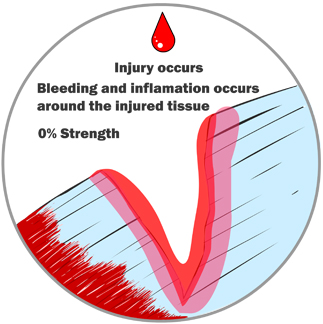
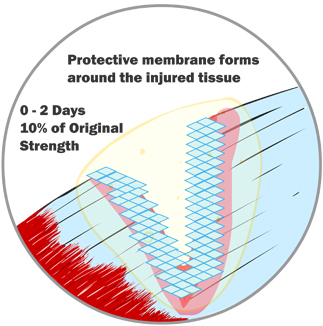
Invariably, when an injury occurs, there is a gap left between the two sides of the wound. At first it may be filled with bodily fluids, but it needs to be filled by new tissue. New muscle, skin, tendon, etc. doesn't grow back right away though. Those special tissues need nerves and blood flow to grow and work properly. In the case of a wound injury, your body first fills the gap with a special kind of tissue (we've simplified it and called it Type 1 tissue here). It is a generic tissue. If the wound is a cut on your skin it is the soft pink tissue that you see right after the scab comes off. The same Type 1 tissue fills the gap regardless of what kind of tissue was injured. It's stronger than the membrane that sealed the injury in the first few hours, but it's not that strong. Type 1 tissue can fill a pretty big gap though. Also, once Type 1 tissue is in place, new capillaries, veins and nerves can grow in and around the new tissue. These systems will be needed for the next steps in wound healing. Type 1 tissue can start forming in as little as 12 hours after your initial injury, but it really does most of its growing between 4 and 24 days after you initially injure yourself. By the end of this stage of healing you likely feel little to no more pain and the injured area is at about 50% of its original strength.
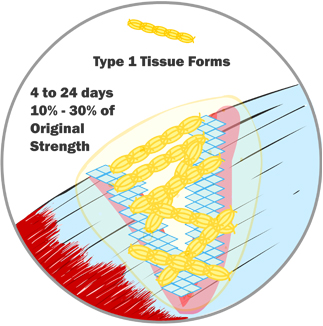
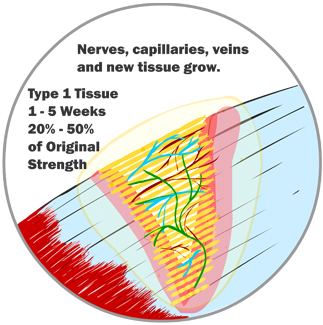
After you have new blood flow and nerves in the area, the Type 1 tissue is replaced by a new Type 2 tissue. With access to proper nutrients from a regular blood supply, this second type of tissue is much stronger. It bonds tightly to the ends of your wound and over time acts like a tightening muscle and pulls the edges of your wound together. This closes the wounded area, making it much smaller. On your skin you see this Type 1 tissue replaced by Type 2 tissue as your scar changes from a flush pink color to a much more pale color. The color changes because it's actually different tissue. As the Type 2 tissue pulls the wound together, we see this as the scar shrinking or fading. If the injury is under your skin, the exact same thing is happening, you just don't see it. This Type 2 tissue is stronger than Type 1 tissue. During this stage, your injury site is at about 70% of the strength it was before the injury. Generally though, it has much less stretch than the final tissue. After all, its purpose is to pull the surrounding tissue together, so it's not supposed to stretch. This shrinking stage typically occurs between 3 months to 1 year after the time of the original injury. During this time people think they have healed, even though the process is not yet complete.
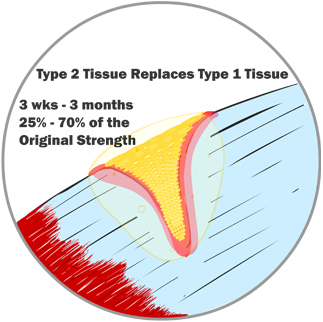
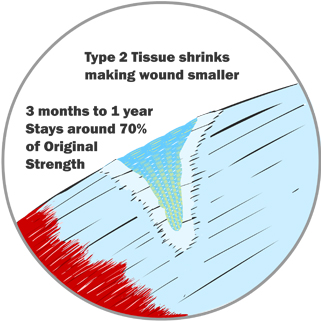
Finally, after the wound has been shrunk as much as possible, your body replaces the Type 2 tissue with the original tissue type that was first injured. Only now does new skin, ligament, tendon, muscle, or cartilage grow. It is after your body replaces the Type 2 tissue with original cells that your wound is considered fully healed. Only now does it regain the same kind of functionality that it once had. This stage can be 1 to 2 years after the original injury though. This is the stage where the scar on your skin would seem to disappear entirely. The new tissue isn't perfect though. The lines of growth probably don't line up perfectly with the lines the old tissue took, so it will never be 100% the same. It can be pretty darn close though. The important thing is that when the Type 2 scar tissue is replaced by real tissue, the function of that tissue can return substantially as well. Only now is the healing process complete.
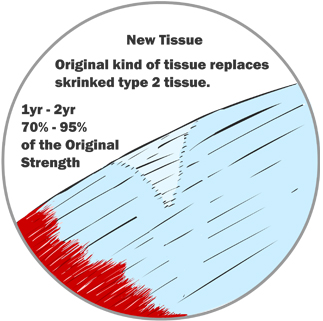
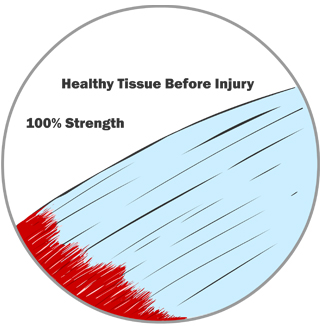
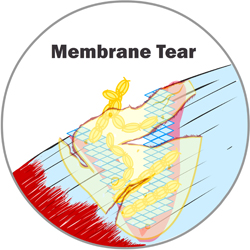
Above we described the perfect healing cycle. As we presented it, there is a clear path from being injured to getting better. For many people though, their injury never seems to heal. This is because in reality we don't just injure ourselves once. After the first injury we constantly re-injure ourselves and this process stops us from getting better.
People almost never let their body heal. Sometimes people have no choice, sometimes people just don't know any better. When you are injured, your body has to go through the process above. There is no short-cut. All these stages take place and they all take time. They take a long time. Regardless, people tend to overstrain their injury before it has healed sufficiently and they constantly re-injure themselves. You're re-injuring yourself every time you feel that 'pain'. You move a certain way and feel the pain or you just go about life and the pain creeps back. Every time you feel pain it's because you've undone some of the healing process. Every time you feel pain it's because you've broken the membrane or torn the Type 1 or Type 2 tissue and your body has to start the healing process for that tissue all over again. If you injure yourself badly enough each time or often enough, the amount of damage you do completely undoes the healing your body has done and you never get better. For people who never give their body a chance, the injury just keeps getting worse.
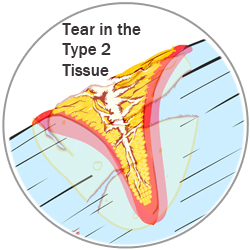
Please take time to understand the healing process we have described. At different stages your body may have only regained 10% or 20% or 50% of its former strength. If you push your body beyond that limit, you're going to tear the tissue open again and reset the healing process back to Stage 1. The pain is usually gone during Stage 2 when only the Type 1 tissue is in place. You may only have regained 20% or 30% of the strength even though 100% of the pain is gone. If you're taking painkillers, your pain may be gone but your tissue strength is only at 10% or 15%. The problem isn't that your body isn't healing. The problem is that you are re-injuring the area again and again and again. This has to stop if you want to get better.
King Brand® offers 2 specific products to help with the healing process. These are not simple consumer goods. These are FDA Registered medical devices that are specially designed for all parts of the body. Our ColdCure® Wraps are specifically for controlling pain and helping with the containment and membrane formation process. This is very important immediately following the injury and for after every re-injury (which, even with the best of intentions, will happen). Our BFST® Wraps are specifically for aiding in the Stage 2, 3 and 4 healing process.

Blood Flow Stimulation Therapy® (BFST®) devices work by stimulating blood flow and lymphatic activity in the healing tissue. Proper circulation is essential to the growth of new tissue. When you're injured and idle though, the circulation in injured tissue is limited. By doing regular BFST® treatments you can stimulate the blood flow to your Type 1, Type 2 and final replacement tissue. This can help it to regrow as quickly and healthily as possible. The healing / re-injury process is almost inevitable. The important thing is to heal as much as you can in between re-injuries. You want to minimize the time it takes to heal and minimize the amount of permanent damage left to the surrounding tissue. Remember, long after the pain goes away, the healing process continues. BFST® treatments should be continued for the entire healing period if you want to regain the maximum amount of strength in the minimum amount of time. How well you heal and how quickly you heal is up to you. How you treat your wounded tissue matters.

Our ColdCure® Wraps have 2 valuable functions. First, immediately after injury, and again after every re-injury, your body has to stop new bleeding and tissue damage. New membranes form around the newly damaged tissue. ColdCure® Wraps help this process by causing the circulatory pathways to contract and reduce flow. This makes it easier for membranes to form and cover/seal the leaks. Both the cold and the compression of the wrap provide this benefit. Many injuries and re-injuries are very painful. A ColdCure® Wrap is an excellent way to treat the pain quickly and effectively. The effectiveness of these devices at relieving pain amaze most people the first time they use them. Many people find them much more effective and faster acting than painkillers. Treatment wise, they are a much better choice because most painkillers can actually interfere with the first stage of the healing process. By 'thinning' the blood, traditional painkillers thwart the membrane containment process. What's worse is that drugs don't treat the injury itself, they only mask the pain. This can lead to feeling a false sense of ability, causing people to re-injure themselves again. If your injury involves ongoing pain and swelling, ColdCure® is an excellent therapeutic choice.